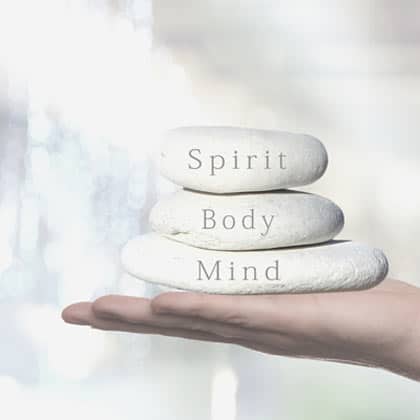Mental health has increasingly become a core focus in Western culture. With apps like Headspace becoming popular across demographics and companies constantly coming up with self-care ritual must-haves, it’s hard to know where some of these core concepts and practices originated from or how to apply them to our lives. Some words that you may have heard in connection with mental health are “mindfulness” and “awareness.”
The difference between mindfulness and awareness is that, while both refer to states of mind, mindfulness involves a lot more introspection and thought process adjustment. Awareness is more sensory-based and is the mental concept that allows us to be more present in the world around us. Both of these concepts feature in meditation practice.
Awareness is similar to mindfulness. Both concepts are a way to stay grounded in the present moment, but awareness also considers the world around you, while mindfulness is an interior concept. Keep reading to learn more about these self-care concepts and how you can apply them to your life.
What is Mindfulness?
Mindfulness has become a bit of a popular self-care concept in the past few decades. When a person is seeking mindfulness, it means they are trying to find more ways to live in the present moment. It is well-known in mental health circles that several disorders can be helped, and their negative symptoms are reduced with basic mindfulness practices and rituals.
Two disorders that can be aided by mindfulness are anxiety and depression.
- Anxiety is an issue that is usually accompanied by many worrying, intrusive thoughts about the future.
- Depression, on the other hand, is usually rooted in negative feelings about past situations and events.
Mindfulness practices can aid either disorder because they help the person suffering from them to avoid ruminating about things that trigger their anxiety or depression.
Mindfulness allows people to live in the present, without fear of the unknown future or shame over the unchangeable past. However, this concept requires a lot of mental training and exercise, such as meditation. Because of how the human brain works, it is very easy for us to drift around to different states of consciousness and focus on either the past or the present.
Here are some other important facts about mindfulness:

- Mindfulness requires intentional effort to center back in the moment, which is one of the reasons it needs to be trained into people who want to live in this kind of mind frame as often as possible.
- Meditation promotes mindfulness and can be pursued through apps (Headspace, Insight timer, Sattva) or practicing meditation with a group or teacher.
- A key aspect of mindfulness is to allow thoughts of varying past or future ruminations to move through your mind without obsession or judgment. Letting these thoughts flow and go without taking up residence in our minds and influencing our moods or behavior is the basis of mindfulness. Instead, students of mindfulness aim to accept their feelings, acknowledge them, and move past them.
Yoga for Mindfulness
While yoga is an excellent exercise for the body, it can also help flex the mind by increasing mindfulness. With the slow movements and relaxing music, this is a practice that can teach you how to exist peacefully within your own body.
The breathwork that is taught (and used) in yoga allows the student to be at peace with who they are, both physically and mentally. The effort involved in holding a challenging pose in yoga anchors a person’s mind to the present moment without the effort of meditation. When holding a pose and focusing on your breathwork, it is difficult to obsess over a bad chat with your boss two weeks ago or what might happen on your next blind date.
Involving this act of intentional mindfulness in your day-to-day lives can help you learn mindful presence and calmness off the yoga mat before you know it. But like any other skill, it does take practice and a calculated effort to become good at yoga or any other mindfulness-based practice.
Depending on what type of yoga you practice or yoga teacher you encounter, mindfulness may be encouraged differently. With some, breathwork is a heavy point of focus. For other yoga practices, incorporating poses like savasana, tadasana, or the famous downward-facing dog pose incites mindfulness.
Benefits of Mindfulness
Aside from the relief it can provide to sufferers of anxiety and depression; there are many other benefits to be gained from practicing mindfulness.
Mindfulness and the mental exercises associated with it can lead help with the following:
- Faster recovery from illness and injury
- Lower blood pressure
- Increased focus

The reason that mindfulness is so effective is that it’s a lot easier to focus on the task at hand—even if it’s a menial task—when you are not concerned about anything other than what you are doing right then. It is also easier for your body to heal when you are not experiencing constant emotional distress. Your blood pressure is bound to go up if you’re worrying yourself into heart palpitations.
Connectedness is something that all humans crave, and it is an important need you possess. When you strive to live in the moment, every dinner with a friend or coffee with a family member feels that much more intentional. Your presence without the interruption of outside thoughts makes for more in-depth, more meaningful conversations. Connectedness has benefits that a person can experience across their lives on multiple levels.
Mindfulness has a significant trickle effect on your lifestyle. While it is often discounted as New Age fluff, this practice has impacted many people’s psychological and physical health in many positive ways. Is it any wonder that people go off on mindfulness retreats and seek smaller ways to work it into their daily lives? Even if it’s just a ten-minute Headspace session as often as you can manage it, it can’t hurt.
What is Awareness?
Awareness is the greatest agent for change.
Eckhart Tolle
In the most basic terms, awareness is the knowledge or perception of a situation or facts. However, the concept of awareness as it pertains to the mental state of consciousness is a bit more complicated than that.
Awareness is not necessarily the same as mindfulness, but the two concepts are intertwined. Awareness acts like a filter of sorts, and when you have a generally strong sense of awareness, you can easily distinguish which of your thoughts are relevant and should be acted upon, and which thoughts are intrusive or disruptive to daily life.
The basis behind the concept of awareness is that people are easily caught up in their thoughts, and it causes them emotional and mental distress. Awareness teaches a level of detachment that allows you to witness your own emotions, rather than only allowing them to wash over you and react to them.
Awareness is a subset of mindfulness. Mindfulness naturally involves awareness. Awareness is the part of mindfulness that allows you to pass your thought process without judgment since individual thoughts are transitory and ultimately unimportant. Awareness is the process that teaches the student to distinguish which thoughts are actual emotions, rather than thoughts, and which are just a running monologue of excessive input from sensory clutter.
Cultivating Self-Awareness
Finding the time and space to hear and categorize your thoughts can be daunting in the modern world. It’s great to be reflective at times, but there is much more benefit involved with cultivating self-awareness in the present moment.
Meditation is a practice that can cultivate both mindfulness and self-awareness since it is a practice that focuses on clearing the mind. This practice requires both sensory perception and self-awareness. Both of these types of awareness can lead to a better understanding of yourself both during and after a session of meditation.

Other tools that are good for cultivating self-awareness are thought dumps and stream-of-consciousness writing, which can reveal the following:
*Subconscious thoughts
*Dreams
*Fears
Once you see these interior thoughts on the page, you can look deeper within yourself to see the source of these thoughts. You can then assess these thoughts to determine which are true and which are illusory. In turn, you can work to reframe or heal any subconscious traumas or mental issues that you come across.
Goal setting is another practice that is effective for cultivating self-awareness.
Recognizing and strategizing your goals can help you better figure out what you need to do, how to think, and how to act to reach them. This practice also enables you to identify the thought processes you have that are not conducive to meeting those goals.
What is Meditation?
Meditation is a practice that is beneficial whether you’re looking to improve your mindfulness or your awareness. But the good news is that all three of these concepts go hand-in-hand, so by improving the one, you will be improving the others, whether it is your goal or not.
Focused attention meditation is a practice in which you aim to focus on one thing and peacefully ruminate on that topic without interruption, either from outside forces or from the storms of interior emotional thought. This form of meditation is one of many types, but for this article, this is the type of meditation being referenced when meditation is mentioned.
How to Meditate
Meditation is a practice with many different methods, so it’s not something that can be done correctly or incorrectly unless you are attempting to follow a specific school of meditation.
It is ideal to be sat upright and in a quiet environment when meditating. Other than that, the most helpful thing you can do is set an intention or focal point for your meditative session. Guided meditation can be a good way for meditation novices to learn to corral their thoughts and return to their focus when they start to go off-track mentally during a meditation session.
The most important part of meditation is to make time to be present with your thoughts, which is a practice that many people find more difficult in practice than in theory. No one is aware of how uncomfortable their stream-of-consciousness is capable of making them until they sit down and subject themselves to it for a half-hour at a time without distractions.
The Headspace website lays it out perfectly: sit up, close your eyes, and let your mind go. Awareness is built when you learn how to redirect your thoughts back to your original point of focus. Even a short meditation session can still help develop the mental fortitude necessary to improve meditation practice.
Types of Meditation
There are many different kinds of meditation. While all of them are centered around the concepts of mindfulness and awareness, they require different implementations. Some (like noting) require much more active awareness than others. There are meditation practices to benefit practically any person’s goals for introspection and tranquility.
Here are some interesting variations on the practice to consider trying out:
- Noting: This method involves bringing your thoughts back around and actively practicing awareness, as mentioned earlier, to keep your brain on track and in a controlled setting. The “noting” refers to keeping a mental note to bring yourself back to when you notice your mind starting to wander.

Some would also refer to this as the anchoring method. This also gives your brain something to think about without accidentally directing it down a rabbit hole. It is essentially just a focal point that allows you to be non-reactive and calm when re-centering yourself.
This is also a practice that is very common in a guided meditation. Guides can redirect you to your note or center very easily without disrupting or jarring your thought process completely. It is productive to see where your mind wanders to so you can reflect on why later, but that is hard to do if you feel you have to stay right on track the whole time. Guided meditation gives a bit of leniency to the practice.
- Reflection: This is exactly what it sounds like—meditation centered around reflecting on your past and setting your sights on where you want to go. There is an overlap – who are you truly and how will that positively or negatively impact who you want to be.

This meditation practice is light on the mindfulness. You have to be somewhat mindful not to shame-spiral when analyzing your darker thoughts, but you also have to delve into thoughts beyond the present moment. This can be a great advanced meditation skill once you have really polished your awareness skills and can reroute your thoughts easily to keep the experience positive.
It is said that this can help people refine their crafts, rediscover old talents they have neglected, or find new ones and give you clarity on your goals and how you may be getting in your way when trying to reach them. This could be considered an intermediate level of meditation since it does require a bit of advanced mindfulness. Still, with practice, any type of meditation can be productive and helpful.
- Chakra meditation: This variety of meditation is a bit more New Age than some of the other disciplines discussed previously. This meditation type is all about chakra balance and being attuned with both your physical and spiritual selves.

Rather than controlling thoughts, chakra meditation aims to control the transfer of energy to certain parts of your body. This is a type of meditation that is easier when you are well versed in practice, as it requires both elements of awareness and mindfulness to be reasonably strong.
This is one of the most advanced meditation practices because it goes beyond the brain and requires a full-body level of awareness that would likely be difficult to achieve even for those well-versed in other meditative methods.
Benefits of Meditation
Beyond lessening anxiety and having fewer depressive thoughts or episodes, meditating is beneficial in many different ways. Energy and focus increase, creativity is enhanced, compassion is easier to find, and your memory can improve as well.
Meditation has also been shown to slow down the aging of peoples’ brains, creating more happy feelings and stability. Therefore, it quite literally can change the chemistry of your brain with adequate practice and training.
Increased awareness and mindfulness have proven to be positive in their own rights, but it goes beyond the surface benefits. When you change your thought processes and train your brain to be on your side, it turns out you can enhance your emotions, brain health, and your life as a result.
Conclusion
While mindfulness and awareness are different, they build upon each other and work hand-in-hand to better your life. And while they do seem like nothing more than buzzwords to most people, they are things that you can exercise to improve your mental, physical, and emotional health.





